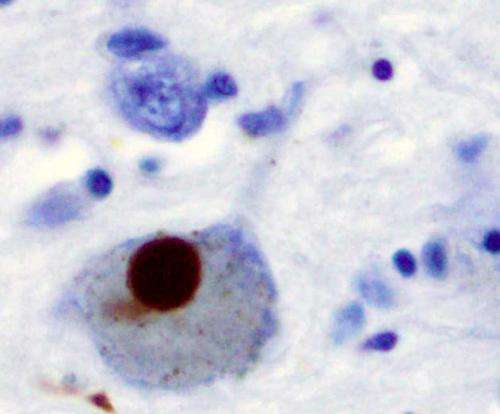Scientists discover a 'switchboard' of molecules that protect against Parkinson's disease

A `switchboard' of molecules that play a vital role in protecting the brain against Parkinson's disease has been uncovered by a research team led by the University of Dundee.
The discovery of these 'switchboard' molecules by scientists at the University's Medical Research Council Protein Phosphorylation and Ubiquitylation Unit (MRC-PPU) solves a mystery of how different genetic causes of Parkinson's are linked at the molecular level.
Previous research had identified that mutations in a gene called PINK1 led to Parkinson's. The PINK1 gene encodes for an important enzyme and, in certain people, its protective effects are lost leading to Parkinson's symptoms due to the degeneration of brain cells controlling movement.
It was believed that PINK1 protects the survival of brain cells by switching multiple targets on or off but the identity of many of these targets was unknown and has been a focus of intense research.
The Dundee scientists analysed tens of thousands of signals using state-of-the-art technology to discover a family of proteins called 'Rabs' that are controlled by PINK1. Rabs are small enzymes that function as molecular switches in cells to turn on or off vital cell processes that regulate cell growth and survival.
The team found that a key role of the PINK1 enzyme is to simultaneously target multiple Rabs and dramatically alter their activity. Their data suggests that an entire 'switchboard' of Rab molecules will play a critical role in protecting brain cells and thus patients from developing Parkinson's disease.
This research opens up new exciting avenues for future research that include studying whether altered levels of the Rabs are associated with the development of Parkinson's. It also suggests that it might be possible to treat Parkinson's by developing drugs that target Rabs.
The team was jointly led by Dr Miratul Muqit and Dr Matthias Trost at the MRC-PPU.
Dr Muqit said, "Parkinson's disease is at present incurable and it is vital we understand the molecular mechanisms in order to design the next generation of therapeutics against the disease.
"In previous work we had outlined a single pathway for PINK1 but the discovery of an entire family of Rabs as PINK1 targets indicates a more complex network of pathways that if disrupted renders brain cells vulnerable to stress and ultimately to the development of Parkinson's.
"Using state-of-the-art technology, we were able to pinpoint how a single gene affects a few proteins among tens of thousands of possible targets. It was like finding the proverbial needle in the haystack."
Dr Trost added, "In the future it will be critical to study this molecular 'switchboard' in more detail in Parkinson's patients. That said, our new research strongly suggests that developing drugs to modulate Rabs represents an exciting new approach to treating Parkinson's."
The research was funded by the Wellcome Trust, Medical Research Council, Parkinson's UK, the Michael J. Fox Foundation, Tenovus Scotland and the Biotechnology and Biological Sciences Research Council.
Dr Arthur Roach, Director of Research at Parkinson's UK, which helped fund the study, said, "People with Parkinson's recognise that the greatest need is for treatments that stop or reverse the condition at an early stage.
"This study points to some proteins that may be changed early in Parkinson's, and suggests ways to design drugs that could stop it in its tracks."
More information: Y.-C. Lai et al. Phosphoproteomic screening identifies Rab GTPases as novel downstream targets of PINK1, The EMBO Journal (2015). DOI: 10.15252/embj.201591593
















